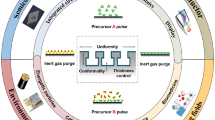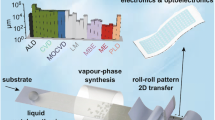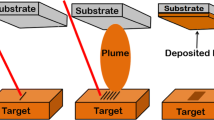Abstract
Deposition of high quality superconducting thin films requires lattice-matched single crystal substrates. This greatly reduces the number of candidate materials to a few expensive substrates that are only available in small sizes. Inexpensive, low-dielectric constant amorphous or polycrystalline substrates would greatly enhance the feasibility of superconducting devices such as HTSC multichip modules. Deposition of HTSC films on aligned dielectric layers allows the use of amorphous and polycrystalline substrates in these structures. Biaxially aligned zirconia thin films have been deposited using ion beam assisted deposition (IBAD) on pyrex, quartz, and Hastelloy substrates. Deposition rate, substrate temperature, ion beam energy, and other processing parameters control the orientation of films deposited by ion beam assisted deposition. Biaxially aligned (200) oriented zirconia has been deposited by IBAD on all three substrates without active substrate heating. Biaxial alignment was not observed in films deposited at 400°C. Increased ion beam energy promotes polycrystalline nucleation at lower temperatures, which is important to the development of biaxial alignment. Other faster growing orientations begin to dominate as the temperature is increased. These results are consistent with a growth and extinction model.
Similar content being viewed by others
References
Y. Lijima, N. Tanabe, and O. Kohno, 4th International Symposium on Superconductivity, Oct 14-17, (1991), 517 Tokyo, Japan. Springer-Verlag, Berlin. Eds. H. Hayakaya and N. Koshizula.
Y. Iijima, N. Tanabe, O. Kohno, and Y. Ikeno, Appl. Phys. Lett. 60, 769 (1992).
R. P. Reade, P. Berdahl, R. E. Russo, S. Garrison, App. Phys. Lett. 61, 2231 (1992).
N. Sonnenberg, A.S. Longo, M.J. Cima, B.P. Chang, K.G. Ressler, P.C. McIntyre and Y.P. Liu, J. Appl. Phys. 74, 1027 (1993).
K.G. Ressler, N. Sonnenberg, and M.J. Cima, Mat. Res. Soc. Symp. Proc., in press (1994).
R. M. Bradley, J. M. E. Harper, and D. A. Smith, J. Appl. Phys. 60, 4160 (1986).
R. M. Bradley, in Handbook of Ion Beam Processing Technology, edited by J. J.Cuomo, S. M. Rossnagel and H. R. Kaufman, (Noyes Publ., Park Ridge, NJ, 1989).
Author information
Authors and Affiliations
Rights and permissions
About this article
Cite this article
Sonnenberg, N., Ressler, K.G., McIntyre, P.C. et al. The Influence of Processing Parameters on the Development of Biaxially Aligned Zirconia Thin Films Deposited by Ion Beam Assisted Deposition. MRS Online Proceedings Library 341, 163–168 (1994). https://doi.org/10.1557/PROC-341-163
Published:
Issue Date:
DOI: https://doi.org/10.1557/PROC-341-163




